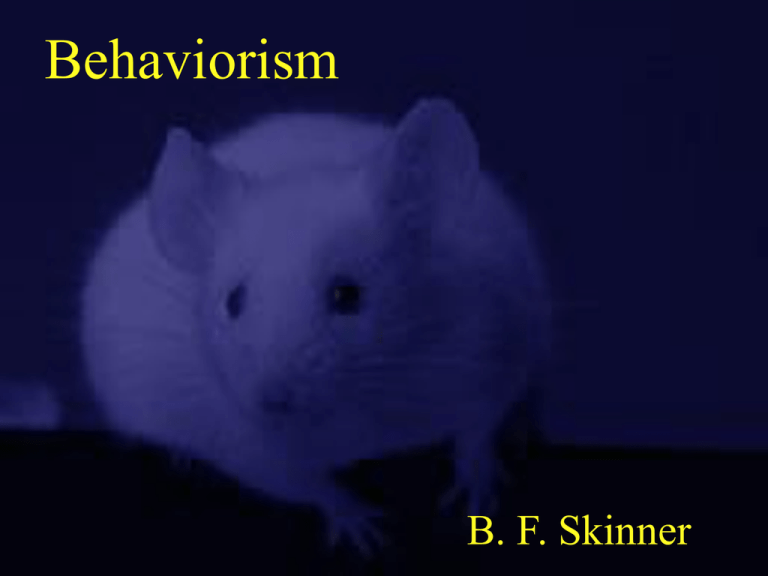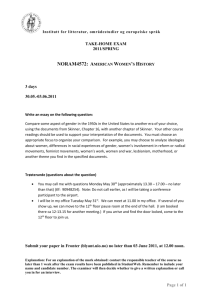B. F. Skinner
advertisement

Behaviorism B. F. Skinner B.F. Skinner (1904-1990) B. F. Skinner (1904-1990) Skinner’s life Predetermined, lawful, and orderly A product of past reinforcements 1925: Hamilton College (NY): degree in English, no courses in psychology Read about Pavlov’s and Watson’s experimental work 1931: Ph.D. from Harvard B. F. Skinner Dissertation: a reflex is a correlation between S and R 1938: The Behavior of Organisms 1953: Science and Human Behavior 1990: Vigorously attacked the growth of cognitive psychology 1990 (final article): "Can Psychology Be a Science of Mind?" B. F. Skinner Dealt only with observable behavior The task of scientific inquiry: To establish functional relationships between experimenter-controlled stimulus and organism’s response No presumptions about internal entities - The "empty organism" approach B. F. Skinner Single subject design Large numbers of subjects not necessary Statistical comparisons of group means not necessary A single subject provides valid and replicable results Requires "sufficient" data collected under wellcontrolled experimental conditions Statistics obscure individual responses and differences B. F. Skinner - Operant conditioning Watson, Pavlov - Respondent behavior: elicited by specific observable stimulus B. F. Skinner Operant behavior: occurs without an observable external stimulus Operates on the organism’s environment The behavior is instrumental in securing a stimulus more representative of everyday learning B. F. Skinner Science of behavior: Study of conditioning and extinction of operants Dependent variable in the "Skinner box": rate of response Law of acquisition key variable: reinforcement practice provides opportunities for additional reinforcement Differs from Thorndike and Hull’s positions Thorndike and Hull: explanatory Skinner: strictly descriptive Skinner’s Theory “All we need to know in order to describe and explain behavior is this: actions followed by good outcomes are likely to recur , and actions followed by bad outcomes are less likely to recur.” (Skinner, 1953) Central Human Motive in Skinner’s Theory Environmental consequences shape behavior LAW OF EFFECT Behavior Better state of affairs Increased probability of behavior occurring again Behavior Worse state of affairs Decreased probability of behavior occurring again Better state of affairs Behavior C emerges as the most probable Behavior A Behavior B Behavior C Behavior D Behavior E Laboratory Examples Operant Conditioning Exploring Pigeon (in a Skinner box) Scratching Key-pecking Grooming Defecating Urinating Reinforcement (food pellet) OPERANT CONDITIONING TECHNIQUES • POSITIVE REINFORCEMENT = increasing a behavior by administering a reward • NEGATIVE REINFORCEMENT = increasing a behavior by removing an aversive stimulus when a behavior occurs • PUNISHMENT = decreasing a behavior by administering an aversive stimulus following a behavior OR by removing a positive stimulus • EXTINCTION = decreasing a behavior by not rewarding it B. F. Skinner Research foci Role of punishment in response acquisition Schedules of reinforcement Extinction of operants Secondary reinforcement Generalization Subjects included humans as well as animals B. F. Skinner Schedules of reinforcement Reinforcement is necessary in operant behavior Reinforcement schedules continuous fixed and variable ratio and interval SCHEDULES OF REINFORCEMENT • Interval schedules: reinforcement occurs after a certain amount of time has passed • Fixed Interval = reinforcement is presented after a fixed amount of time • Variable Interval = reinforcement is delivered on a random/variable time schedule • Ratio schedules: reinforcement occurs after a certain number of responses • Fixed Ratio = reinforcement presented after a fixed # of responses • Variable Ratio = reinforcement delivery is variable but based on an overall average # of responses LIMITED EFFECTS OF PUNISHMENT • • • • Punishment does not teach appropriate behaviors Must be delivered immediately & consistently May result in negative side effects Undesirable behaviors may be learned through modeling (aggression) • May create negative emotions (anxiety & fear) HOW COMPLEX BEHAVIORS ARE LEARNED • Successive approximation/shaping = reinforcing behaviors as they come to approximate the desired behavior • Superstitious Behavior = when persistent behaviors are reinforced coincidentally rather than functionally • Self-control of behavior Stimulus avoidance Self-administered satiation Aversive stimulation Self-reinforcement B. F. Skinner Verbal behavior Speech Comprised of responses Can be reinforced by speech sounds or gestures B. F. Skinner Aircribs and teaching machines 1945: aircrib Teaching machine invented in the 1920s by Pressey promoted by Skinner 1968: The Technology of Teaching B. F. Skinner Walden Two (1948): A behavioristic society Program of behavioral control A technology of behavior Application of laboratory findings to society at large B. F. Skinner Behavior modification Used in a variety of applied settings Reinforce desired behavior and extinguish undesired behavior Punishment is not used B. F. Skinner Criticisms of Skinner’s behaviorism His extreme positivism His opposition to theory His willingness to extrapolate beyond the data The narrow range of behavior studied Problem of instinctive drift His position on verbal behavior B. F. Skinner Contributions of Skinner’s behaviorism Shaped American psychology for 30 years His goal: the improvement of society Srength and ramifications of his radical behaviorism Social Learning Theories: The Cognitive Challenge The context Skinner (1963): "Behaviorism at Fifty" Progress in experimental psychology in U.S. due to behaviorism Social learning/sociobehaviorist approach fomented by many, including some behaviorists, reflected broader cognitive revolution in psychology 1995: consciousness has overtly and publicly returned to psychology









